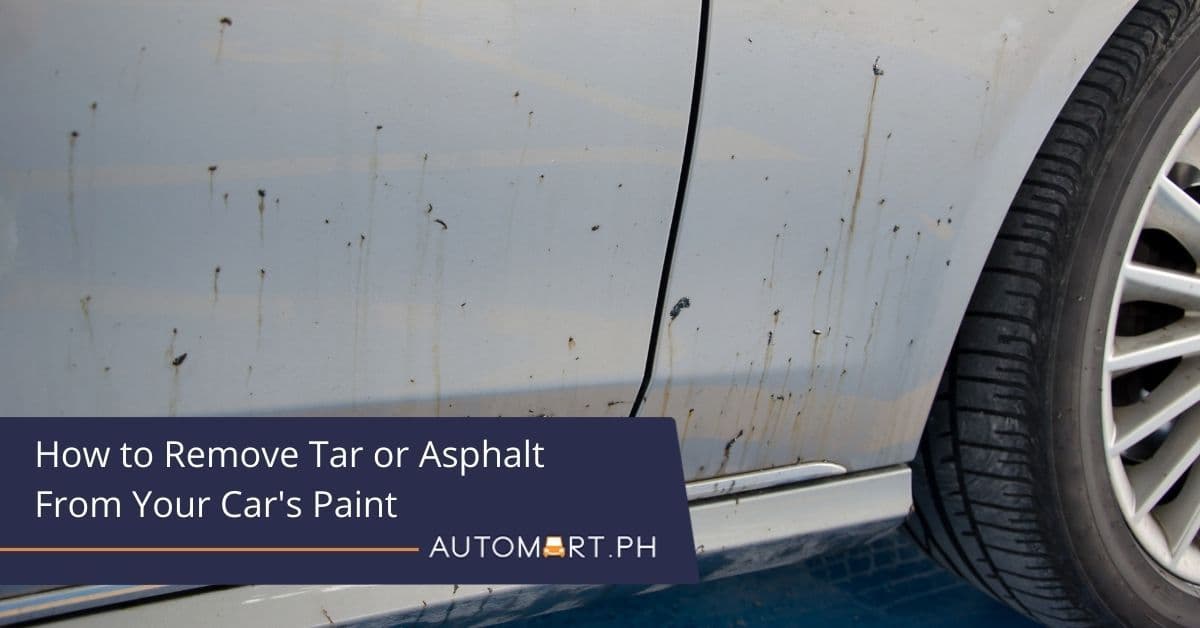
How to Remove Tar or Asphalt From Your Car's Paint
Updated on December 18 2025
Out of all the things that can adhere to your car's paint, tar, asphalt, or road grime are among the most difficult to remove. Tar is even harder to eliminate than dried-on bird poo, and you can easily scratch, swirl, or damage the paint if not careful. In addition, tar spots are resistant to plain soap and water, and you can't erase them with a basic car wash.

The worst part? When you wash off the asphalt stains, it leaves behind ugly streaks of tar as you wipe the finish, creating more stains and marks than when you started. But instead of scratching your head in frustration, here are tips on how to remove tar or asphalt from your car's paint without the dangers of scratching or swirling the finish.
What is tar, and how does it stick to my car's paint?
Tar or asphalt is everywhere on Philippine roads. It's a sticky, black substance utilized in road construction and paving. However, asphalt stains are leftover binding materials that get picked up by the tires and flung to your vehicle's wheel wells, undercarriage, fenders, and the lower part of the doors and bumpers. You could also find tar spots on your car's hood.
Does tar cause permanent damage to the paint?
Yes. If left baking on your car's finish, tar and asphalt could dig into the clear coat and damage the layer of color underneath. When hot asphalt flings to the surface, it can also attract dirt and debris that stick on the tar before it dries, and this can cause paint chips and deep scratches.

How to Remove Tar and Asphalt From Car Paint
The easiest and fastest way to remove asphalt from car paint is to use tar removal sprays. Tar remover or asphalt remover is a chemical product that breaks down and dissolves tar spots on a molecular level. But if you don't have a tar remover, you can use WD-40 or a clay bar to get the job done.
Removing Asphalt with Chemical Sprays
Step 1: Wash the vehicle with a wash mitt and car shampoo. When removing tar, asphalt, or other paint contaminants, always start with a clean surface to further reduce the possibility of scratching the paint.
Step 2: Spray the chemical product directly on the tar spots and asphalt stains and allow it to soak on the surface for two to five minutes.
Step 3: After letting the cleaning solution dwell on the surface, grab a mildly damp microfiber towel and wipe off the excess. Turn the towel over and buff the surface lightly.
Step 4: The last step is to apply polish and wax. Polish will level the surface and eliminate the microscopic peaks and valleys left behind by the tar spots. But if you don’t have time, the least you can do is wax the treated surface to seal the finish. Apply wax using a clean applicator pad, wait for the wax to dry to a haze, and buff off using a dry microfiber towel.
How to Remove Asphalt Stains with WD-40
Step 1: Wash the vehicle with clean water and car shampoo. Wipe the surfaces dry using a microfiber towel.
Step 2: Spray WD-40 directly on the tar spots and allow the product to soak for five to ten minutes. Here’s a quick rule of thumb: the longer you let it soak, the easier it is to remove later on.
Step 3: Grab a separate towel, spray WD-40 on the towel, and wipe off the soaked-in tar spots using quick back-and-forth motions until all the tar spots are gone. Turn the towel over frequently if you’re dealing with more stains than usual to prevent rubbing back the tar on the paint.

Step 4: Wash all treated surfaces with water and car shampoo to remove all traces of WD-40 on the finish.
Step 5: Dry the surface with a separate towel and apply wax to seal the finish. As usual, allow the wax to dry to a haze before wiping it off with a clean towel for maximum effect.
How to Remove Tar Using a Clay Bar
If you don’t like using chemicals or lubricants, you can use a clay bar to remove tar spots and asphalt stains from your car’s paint. The trick in using a clay bar is to lubricate the surface as you wipe it with clay to prevent scratching and swirling.
Step 1: Wash the vehicle using a wash mitt and car shampoo. Rinse well with clean water afterward.
Step 2: Grab the clay and knead it to shape.
Step 3: Wet the contaminated surface with a detailer spray, car shampoo, or clay lubricant. The trick to using a clay bar is to maintain lubrication as you wipe.

Step 4: Wipe the clay bar gently in a back and forth motion after wetting or lubricating the surface. Apply more lubricant as required, and remember to knead the clay repeatedly once it gets dirty.
Step 5: Rinse the treated area with clean water and wipe dry using a microfiber towel.
Step 6: Wax the paint after treating it with a clay bar. Apply wax, allow to dry for five to ten minutes, and wipe off the excess with a dry microfiber towel.
Conclusion
Avoid removing asphalt or tar stains using your fingernails. It’s a surefire way of inducing scratches, pits, and visible damage on the paint. Additionally, you should avoid rubbing the surface incessantly unless you want to deal with deep scratches and swirl marks later on.